Bothroponera strigulosa
| Bothroponera strigulosa | |
|---|---|

| |
| Scientific classification | |
| Kingdom: | Animalia |
| Phylum: | Arthropoda |
| Class: | Insecta |
| Order: | Hymenoptera |
| Family: | Formicidae |
| Subfamily: | Ponerinae |
| Tribe: | Ponerini |
| Genus: | Bothroponera |
| Species group: | pumicosa |
| Species: | B. strigulosa |
| Binomial name | |
| Bothroponera strigulosa Emery, 1895 | |
Specimens pf this species have all been found in grasslands.
Identification
Joma and Mackay (2015) - A member of the Bothroponera pumicosa species complex. The head of the worker is subquadrate and the mandibles are smooth and covered with hairs. The anterior medial margin of the clypeus is convex and forms a “u” shaped edge, and the clypeus has a raised medial sharp carina which extends from the base of the frontal furrow to the lower medial margin of the clypeus.
Bothroponera strigulosa is similar to Bothroponera cariosa, and Bothroponera pumicosa, as they all have a “u” shaped anterior medial margins of the clypeus. Bothroponera strigulosa is quite similar to B. cariosa, but it can be distinguished because the mandibles of B. strigulosa are smooth and shiny while in B. cariosa they are covered with fine striae. The mandibles in B. pumicosa are hairy and smooth. The hairs are long (from 0.20 up to 0.55 mm) in B. pumicosa while they are short in B. strigulosa (from 0.05 up to 0.32 mm) and B. cariosa (from 0.05 up to 0.25 mm).
The characters of Bothroponera strigulosa are similar to those of Bothroponera berthoudi. The only apparent differences between them are that the raised medial area of the clypeus of B. berthoudi is smooth and the clypeal carina is not present, but B. strigulosa has a clypeal carina (it partially forms a carina in B. pumicosa). The erect golden hairs on most surfaces are slightly longer in B. berthoudi than those of B. strigulosa.
Keys including this Species
Distribution
Latitudinal Distribution Pattern
Latitudinal Range: -17.30929° to -29.86667°.
| North Temperate |
North Subtropical |
Tropical | South Subtropical |
South Temperate |
- Source: AntMaps
Distribution based on Regional Taxon Lists
Afrotropical Region: South Africa (type locality).
Distribution based on AntMaps
Distribution based on AntWeb specimens
Check data from AntWeb
Countries Occupied
| Number of countries occupied by this species based on AntWiki Regional Taxon Lists. In general, fewer countries occupied indicates a narrower range, while more countries indicates a more widespread species. |

|
Estimated Abundance
| Relative abundance based on number of AntMaps records per species (this species within the purple bar). Fewer records (to the left) indicates a less abundant/encountered species while more records (to the right) indicates more abundant/encountered species. |

|
Biology
Castes
     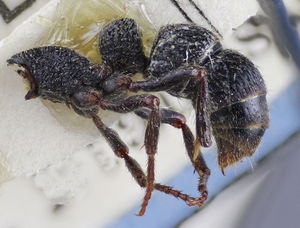   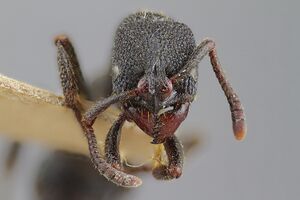 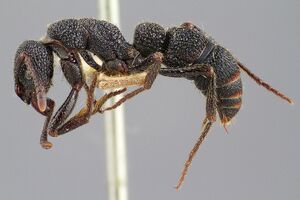 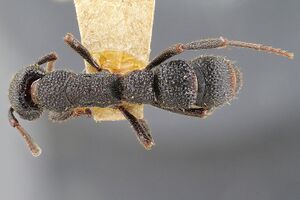 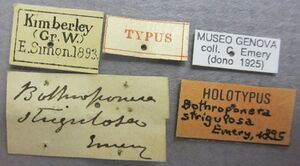
| |
| . | Owned by Museum of Comparative Zoology. |
Nomenclature
The following information is derived from Barry Bolton's Online Catalogue of the Ants of the World.
- strigulosa. Bothroponera strigulosa Emery, 1895h: 19 (w.) SOUTH AFRICA.
- Type-material: holotype worker.
- Type-locality: South Africa: Kimberley, i.-iv.1893 (E. Simon).
- Type-depository: MSNG.
- Combination in Pachycondyla (Bothroponera): Emery, 1901a: 45;
- combination in Pachycondyla: Arnold, 1926: 201; Brown, in Bolton, 1995b: 310;
- combination in Bothroponera: Wheeler, W.M. 1922a: 72; Joma & Mackay, 2013: 3; Schmidt, C.A. & Shattuck, 2014: 76.
- Status as species: Forel, 1901f: 344; Emery, 1911d: 76; Arnold, 1915: 61; Wheeler, W.M. 1922a: 72 (in key), 773; Arnold, 1926: 201; Arnold, 1952a: 461 (in key); Bolton, 1995b: 310; Joma & Mackay, 2015: 558 (redescription).
- Distribution: South Africa.
Unless otherwise noted the text for the remainder of this section is reported from the publication that includes the original description.
Description
Worker
Joma and Mackay (2015) - (n=1), HL 2.50, HW 2.10, ML 1.35, EW 0.35, EL 0.45, SL 1.65, FL 2.50, WL 3.60, WPL 4.50, PL 1.15, PW 1.35, PH 1.45, CI 84, OI 21.42, MandI 54, SI 79, PetI 117.39. Total length 12.20 mm; mandibles triangular with 7 teeth, smooth, moderately covered with hairs (0.10 - 0.20 mm long); clypeal length 1.85 mm; scape nearly reaches posterior lateral corner of head; malar space from lower edge of eye to base of mandible 0.38 mm; length from upper edge of eye to edge of posterior lobe 1.10 mm; surface of head coarsely foveolate; frontal lobes rounded, smooth, shiny with width of 0.85 mm; pronotal shoulder rounded; two sharp angles on anterior (anteroinferior pronotal process) posterior (inferior pronotal process) ends of lower margin of pronotum (lateral view); basalar sclerite rounded; lower part of mesopleural suture well developed with mesopleuralcoxal excavation; petiole in dorsal view rounded, slightly narrowed anteriorly, anterior face vertical (side view), slightly concave posteriorly (side view) with slight depression on upper medial margin (top view); mesosoma 3.4 mm, gaster length 4 mm; antennae, edges of frontal lobes, mandibles and legs shiny; pronotum, mesonotum, propodeum, lateropropodeum, metapleuron densely foveolate, punctate; posteropropodeum rough, slightly concave; petiolar and postpetiolar surfaces densely covered with larger foveolae than those of mesosoma; postpetiolar dorsum partially covered with striae; second – fifth gastral segments densely covered with foveolae, punctures that become smaller, shallower posteriorly; postpetiolar dorsum partially covered with striae; dorsum of 2nd - 5th segments of gaster covered with fine striae; short (0.05 – 0.22 mm) golden hairs distributed on entire body including mandibles, clypeus, head, scape, legs; top of the head covered with short (0.05 - 0.13 mm) golden erect hairs; dorsum of pronotum, mesonotum, propodeum covered with short golden erect hairs (0.07 - 0.13 mm, a few up to 0.18 mm); petiole (0.08 - 0.22 mm), postpetiole covered with moderately short erect hairs (0.12 - 0.18 mm); sternopetiolar and sternopostpetiolar processes and 3rd to 7th abdominal segments covered with moderately long hairs (0.11 – 0.22 mm); ventral surface of gastral segments and between segments (0.15 - 0.32 mm); pygidium and hypopygium (up to 0.30 mm); head, scape, pronotum, mesonotum, mesopleuron, propodeum, petiole, postpetiole, entire gaster, legs black or dark-brown; mandibles, funiculus, frontal lobes reddish brown.
Type Material
Joma and Mackay (2015) - South Africa: Northern Cape Province, Kimberley, 1230 m [4040 ft] (Gr. W.), 28°44’0’’ S; 24°46’0’’, E, E. Simon 1893, Bothroponera strigulosa (Emery, 1895), Museo Geneva coll., Emery (dono 1925) (1w Holotype, Museo Civico di Storia Naturale, Genoa).
References
- Arnold, G. 1952a. New species of African Hymenoptera. No. 10. Occas. Pap. Natl. Mus. South. Rhod. 2: 460-493 (page 460, Senior synonym of berthoudi)
- Brown, W. L., Jr. 1995a. [Untitled. Taxonomic changes in Pachycondyla attributed to Brown.] Pp. 302-311 in: Bolton, B. A new general catalogue of the ants of the world. Cambridge, Mass.: Harvard University Press, 504 pp. (page 310, combination in Pachycondyla)
- Emery, C. 1895i. Voyage de M. E. Simon dans l'Afrique australe (janvier-avril 1893). 3e mémoire. Formicides. Ann. Soc. Entomol. Fr. 64: 15-56 (page 19, worker described)
- Emery, C. 1901b. Notes sur les sous-familles des Dorylines et Ponérines (Famille des Formicides). Ann. Soc. Entomol. Belg. 45: 32-54 (page 45, Combination in Pachycondyla (Bothroponera))
- Joma, A.M.A. & Mackay, W.P. 2015. Revision of the African ants of the Bothroponera pumicosa species complex (Hymenoptera: Formicidae: Ponerinae). Sociobiology 62: 538-563 (doi:10.13102/sociobiology.v62i4.845).
- Joma, A.M.A., Mackay, W.P. 2020. Revision of the African ants of the Bothroponera talpa species complex (Hymenoptera: Formicidae: Ponerinae). Transactions of the American Entomological Society 146: 355-408. (doi:10.3157/061.146.0206).
- Schmidt, C.A. & Shattuck, S.O. 2014. The higher classification of the ant subfamily Ponerinae (Hymenoptera: Formicidae), with a review of ponerine ecology and behavior. Zootaxa 3817, 1–242 (doi:10.11646/zootaxa.3817.1.1).
- Wheeler, W. M. 1922b. Ants of the American Museum Congo expedition. A contribution to the myrmecology of Africa. II. The ants collected by the American Museum Congo Expedition. Bull. Am. Mus. Nat. Hist. 45: 39-269 (page 72, Combination in Bothroponera)
References based on Global Ant Biodiversity Informatics
- Arnold G. 1926. A monograph of the Formicidae of South Africa. Appendix. Annals of the South African Museum. 23: 191-295.
- Forel A. 1901. Nouvelles espèces de Ponerinae. (Avec un nouveau sous-genre et une espèce nouvelle d'Eciton). Revue Suisse de Zoologie 9: 325-353.
- IZIKO South Africa Museum Collection
- Joma A. M. A., and W. P. Mackay. 2012. A new species of Afrotropical ants in the genus Bothroponera (Hymenoptera: Formicidae: Ponerinae). Psyche 2013: Article ID 917847, (doi:10.1155/2013/917847): 8 pp.

